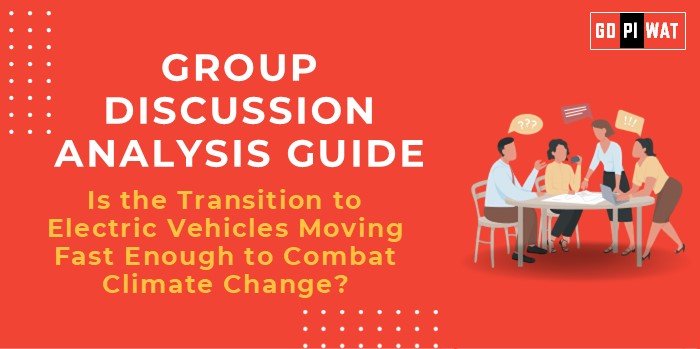📋 Group Discussion (GD) Analysis Guide
🌍 Topic: Is the Transition to Electric Vehicles Moving Fast Enough to Combat Climate Change?
🌟 Introduction to the Topic
Opening Context: Transitioning to electric vehicles (EVs) is a critical step in reducing global greenhouse gas (GHG) emissions, especially from the transport sector, which accounts for nearly 23% of energy-related CO₂ emissions worldwide.
Topic Background: The rise of EVs stems from the need to combat air pollution and reduce dependency on fossil fuels. Nations are setting ambitious EV adoption targets, but the pace varies widely due to economic, technological, and policy challenges.
📊 Quick Facts and Key Statistics
- Global EV Sales (2023): 14% of total vehicle sales, up from 4% in 2020 – highlighting rapid growth.
- India’s EV Market Share: Around 2% in 2023; government target: 30% by 2030.
- Carbon Emission Reduction Potential: EVs can reduce emissions by 30-50% compared to internal combustion engine (ICE) vehicles.
- Battery Costs: Dropped by 89% since 2010, but raw material scarcity remains a concern.
- Global Leaders: Norway (90% EV market share in 2023) sets an example for rapid EV adoption.
🔑 Stakeholders and Their Roles
- Governments: Setting policies, offering incentives, and building EV infrastructure.
- Automakers: Innovating and scaling production to meet demand.
- Energy Providers: Ensuring green electricity supply for EV charging.
- Consumers: Driving demand and advocating for sustainable transport.
- International Organizations: Providing frameworks and funding for EV transitions.
✅ Achievements and Challenges
Achievements
- Policy Milestones: Subsidies, tax rebates, and incentives introduced globally.
- Technological Advances: Improved battery performance and affordability.
- Infrastructure Growth: Over 3 million public charging stations worldwide (2023).
- Reduced Emissions: EV adoption cut CO₂ emissions by 150 million metric tons in 2022.
Challenges
- Infrastructure Gaps: Insufficient charging networks in rural and developing areas.
- High Initial Costs: EVs remain expensive for many middle-income consumers.
- Resource Scarcity: Limited availability of lithium and cobalt for batteries.
- Grid Overload: Growing demand strains electricity grids.
Global Comparisons: Norway’s success due to subsidies and stringent ICE policies, vs. China’s dominance as the largest EV market through aggressive local manufacturing.
💬 Structured Arguments for Discussion
- Supporting Stance: “The transition is progressing at an unprecedented pace, with EV sales doubling globally in three years.”
- Opposing Stance: “Despite advancements, the current adoption rate is insufficient to meet the 1.5°C climate target.”
- Balanced Perspective: “While significant progress has been made, infrastructure and policy gaps must be addressed to accelerate EV adoption.”
💡 Effective Discussion Approaches
- Opening Approaches:
- “With EV sales reaching 14% globally, are we truly moving fast enough to limit climate change?”
- “While EV adoption is surging, roadblocks like high costs and inadequate charging networks hinder progress.”
- Counter-Argument Handling: Highlight innovative solutions like battery recycling or renewable-powered grids to counter economic and environmental concerns.
📈 Strategic Analysis (SWOT)
- Strengths: Emission reduction, lower operational costs, technological innovation.
- Weaknesses: High initial investment, resource limitations, uneven adoption rates.
- Opportunities: Renewable energy integration, global market expansion, government incentives.
- Threats: Supply chain bottlenecks, geopolitical tensions, and consumer skepticism.
🎓 Connecting with B-School Applications
- Real-World Applications: Explore EV adoption in urban logistics, supply chain greening, or renewable energy-powered transport.
- Sample Interview Questions:
- “What are the economic implications of EV subsidies?”
- “How can EVs support sustainable urban mobility projects?”
- Insights for Students: EV case studies can inform projects on sustainable innovation, urban planning, and international policy comparisons.


